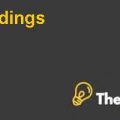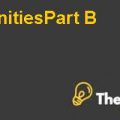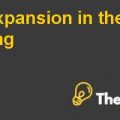Reasons for taking Decisions:
Managing the excess cash was the main reason of the company’s managementand for that management of the company was revising its capital structure. If the company uses the $400 million of excess cash position and issues, debts either at 40% or either at 80% than it would create an opportunity for Bed Bath & Beyond to repurchase its existing outstanding shares that would help the company to improve its net earnings as well as EPS and it would also improve its return for the equity investors as well. If the equity investor’s return will improve then the investors would not divest its holdings from the company and retain it further.
The calculation in the Excel sheet under PV of Tax shield shows that if company uses the 40 percent debts and $400 million of excess cash for the repurchase of shares than the total number of 28,009 shares would be repurchased. If BBBY uses the 80% debts and $400 million of excess cash than it would repurchase 45,135 shares.
At 40 percent debt the shares would be repurchased at the $37 per share price that would increase the earning per share around $1.41 and diluted earnings per share of around $1.31. This EPS and diluted EPS is slightly higher than the previous earnings per shares which is around $1.35 for EPS and for diluted EPS it is around $1.31. On the other hand, if the company would go for using the 80% debt capacity that from its $400 million of excess cash it would increase its earning per share that would be around $1.44 and diluted EPS is around 1.39 both of these EPS are higher than the previous EPS.
Please refer the below table 1 and graph for improved EPS and Diluted EPS.
Table 1:
| Current | 40% Debt Financing | 80% Debt Financing | |
| EPS | 1.35 | 1.41 | 1.44 |
| Diluted EPS | 1.31 | 1.37 | 1.39 |
On the other hand, this improved EPS would boost the investor’s confidence and investors would retain their position in the BBBY that would further result in improving the company’s overall worth. If the company wanted to avail this debt financing, then from this financing it would expand its operations that would result in improving the investment returns.The calculation in the excel sheet shows that if BBBY revised its capital structure by 40% in terms of debt capacity than it would generate a return on equity around 40% that is significantly higher than theprevious returns. On the other hand, if the company uses 80% debt capacity than the retainer on equity would be around 113% that is also showing the substantial incremental results in terms of return on equity.
In addition to the return on invested capital the calculation made in the excel sheet also showing the improved results such as, 34.12%, which is significantly higher than the previous returns generated from investing capital of around 25.70%.
On the other hand it would increase the interest payments that would result in reducing the returns, but it also decreases the invested capital and that amount of decreased capital and return generated on that capital is equally improved as a whole that is showing the improved returns.
Critical Analysis of Decision
In the Excel Sheet it shows that the company has reported an interest coverage ratio around 22.5% under the 40% debt capacity and 11.3% under the 80% debt capacity to finance its future expansion. If a company uses the 80% debt capacity than the interest coverage ratio is lower which could raise the concerns about the company’s ability to pay off its debts. On the other hand, the EBITDA interest coverage ratio shows that if company pursue 40% debt capacity utilization than the interest coverage ratio would be around 25.5% if BBBY pursue the80% of debt capacity utilization, then the interest coverage ratio would be around 12.6%.
In both cases the, the interest coverage ratio would deteriorate the company’s net earnings that would result in reducing the net profit of the Bed Bath & Beyond. The net profit under 40% debt capacity utilization would be around $378,964 and under 80% debt capacity utilization the net profit would be around $361,427.
Please refer the Table 2 and below Graph for the Interest Coverage Ratio and EBITDA Interest Coverage Ratio.
Table 2:
| Current | 40% Debt Financing | 80% Debt Financing | |
| Interest Coverage |
0 |
22.5 | 11.3 |
| EBITDA Interest Coverage |
0 |
25.5 | 12.6 |
Furthermore, it would also threaten the credit rating of the company and reduces the rating in the market that helps in raising capital from the financial sector................................
This is just a sample partial case solution. Please place the order on the website to order your own originally done case solution.














